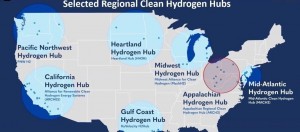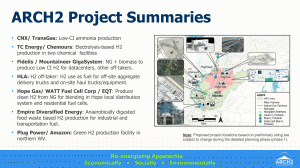West Virginia Needs Statewide Development But ARCH2 is Speculative & Very Expensive
From an Article by Brad McElhinny, WV Metro News, October 29, 2023
An Appalachian hydrogen hub, which made a splash this month when the region was selected for nearly a billion dollars in federal support, is still a work in progress. The early vision for the hub sprawls across West Virginia and Appalachian communities in surrounding states with interconnected pieces to produce hydrogen power, store carbon dioxide emissions and use the hydrogen power for activities like transportation or data storage.
But even the highest-level supporters of the project aren’t yet ready to say exactly what it will be like. “The hydrogen hub really offers us, as West Virginia, the opportunity to continue to be powering the nation and is also where the innovation is going to be occurring,” Senator Capito said during a news briefing with state reporters.
“These nodes that they talk about — that’s why I think it’s exciting for our state: it’s not just going to be concentrated in one specific area. It will offer us opportunities to develop hydrogen for uses in power, in advanced manufacturing, in heavy-duty transportation and, in my understanding from some of my initial conversations, in some of the chemical making.”
For example, Capito took note of early plans for the Chemours site at Washington Works in Wood County to develop electrolysis-based hydrogen production — providing power to the plant and possibly for others in the area. A similar idea is likely to take shape at the Chemours site at Belle, Kanawha County.
“They are looking forward to transforming some of their manufacturing from natural gas to hydrogen so we have a ready customer right there that has proven technologies. I think that gives us an idea of what our future could be here in terms of where the uses are. In terms of the process, it is a lengthy process.”
Planners this past week described a key distinction: although the project has been selected by federal officials for further advancement, it has not yet been approved. Approval is likely to occur early next year, leading then to a detailed plan process of 12 to 18 months.
“So selected applicants are just now exiting the application phase and entering into a period of negotiation that will take months to finalize. And during this negotiation period, applicants will refine their proposals further and better define plans, including those for community benefits,” said Lydia Kubiak-Cardona, a community engagement specialist with the U.S. Department of Energy’s Office of Clean Energy Demonstrations.
That means the hub — and the economic projects that encompass it — will move and shift somewhat over the next few years.
President Joe Biden and officials with the U.S. Department of Energy on Oct. 13 announced the Appalachian hydrogen hub and six similar projects across the nation. The total federal support is $7 billion, with the Appalachian project in line for $925 million of that. Private investment is already lining up and will put up billions more in financial support.
During an initial background session for reporters, senior Biden administration officials described production nodes in Belle in Kanawha County, Follansbee in Brooke County, Washington in Wood County, Point Pleasant in Mason County and Fairmont in Marion County.
In a followup session with Senate Energy Chairman Joe Manchin, D-Monongalia, and U.S. Energy Secretary Jennifer Granholm, officials said the ARCH2 hub will be headquartered in Morgantown.
Appalachian counties in Ohio and Pennsylvania are also participating in the hub. Officials said the project is geared toward the rich supplies of natural gas in the region, although some aspects of the project also rely on producing “green hydrogen” from renewable sources.
That’s the broad picture for the time being — although not exactly overflowing with detail. During a livestreamed community briefing this week, project developers said that as the hub now moves toward full approval some aspects of the participation could change.
“I want to emphasize that we’re at the very beginning of a long process,” said Suzy Baker, the engagement lead for the hub projects. “These hubs are going to take many years to come to fruition and will have to pass through several stages before any construction activities can start.”
Broadly, the hub includes both “green hydrogen” and “blue hydrogen” producers, natural gas pipelines, below-surface carbon dioxide injector storage and more. Some locations are labeled as “plug power” for heavy-duty transportation fuel stations.
“We wanted to put together a proposal that represented the communities, the companies and really different end uses,” said Shawn Bennett, division manager for energy and resilience at Battelle, one of the companies at the center of the hydrogen hub’s development.
“When you think about the large scale of this opportunity, we’ve brought in a lot of great partners.”
Maps that the developers showed during the presentation depicted:
>>> a CNX/Transgas ammonia production facility in southern West Virginia: “With what’s happening with Russia’s invasion of Ukraine really exacerbating fertilizer prices, ammonia prices, this is an opportunity for us to reshore a lot of that pneumonia,” Bennett said.
>>> two TC Energy/Chemours facilities around the Kanawha Valley to produce hydrogen through electrolysis: “So really transitioning to a low-carbon intensity retrofit for powering their chemical facilities,” Bennett said.
>>> a Fidelis/Mountaineer Gas “GigaSystem” site in the mid-Ohio Valley to use natural gas and biomass to produce hydrogen for data centers and other consumers: “Just a huge investment here, looking at producing low-carbon intensity hydrogen for data centers and other off-takers in the region,” Bennett said. “Really, it’s a pure hydrogen producer.”
>>> a Hog Lick Aggregates site in north central West Virginia to use hydrogen to fuel delivery trucks, haul trucks and equipment: “They’re decarbonizing the mining sector there,” Bennett said, “by retrofitting their trucks to run on hydrogen instead of diesel.”
>>> a Hope Gas/WATT Fuel Cell Corp/EQT location in central West Virginia to produce hydrogen from natural gas for Hope’s local distribution system and residential fuel cells: “So finding those communities who may have electricity that kind of goes in and out,” Bennett said, “providing them an opportunity for backup power — something that is reliable and something they can use all the time.”
>>> an Empire Diversified Energy site at the tip of the Northern Panhandle producing hydrogen through anaerobically-digested food waste for industrial and transportation fuel:”They’re using anaerobically digested food waste for hydrogen production.”
>>> and a Plug Power/Amazon site in northern West Virginia to produce “green hydrogen” “This is a project that is up near Weirton, producing green hydrogen in a production facility and then partnering with Amazon and powering their trucks for over-the-road trucking and long-distance trucking.”
But the slide showing that potential development also warned: “Proposed project locations based on preliminary siting are subject to change during the detailed planning phase.”

